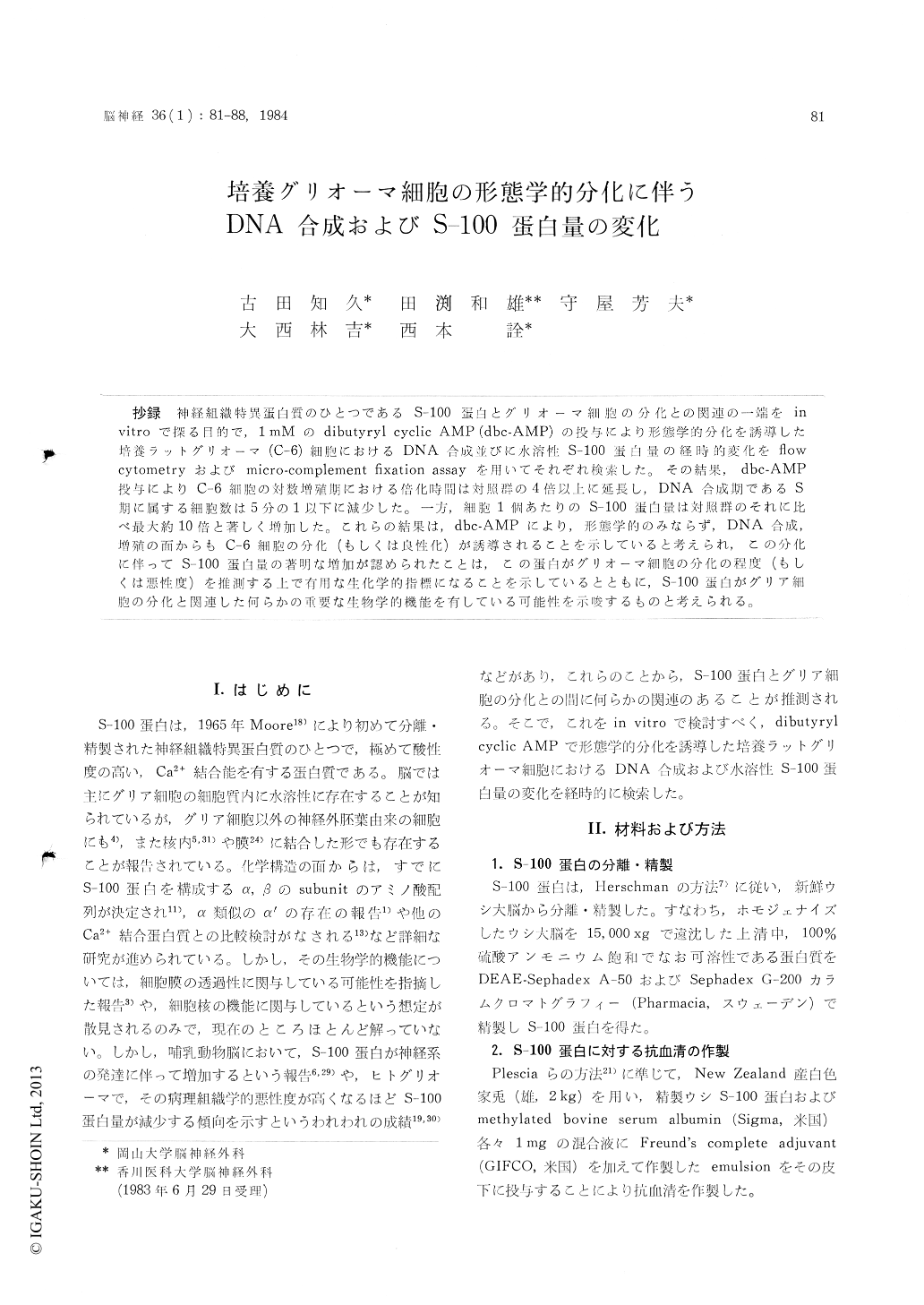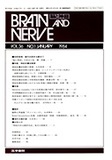Japanese
English
- 有料閲覧
- Abstract 文献概要
- 1ページ目 Look Inside
抄録 神経組織特異蛋白質のひとつであるS−100蛋白とグリオーマ細胞の分化との関連の一端をinvitroで探る目的で,1mMのdibutyryl cyclic AMP (dbc-AMP)の投与により形態学的分化を誘導した培養ラットグリオーマ(C−6)細胞におけるDNA合成並びに水溶性S−100蛋白量との経時的変化をflowcytometryおよびmicro-complement fixation assayを用いてそれぞれ検索した。その結果,dbc-AMP投与によりC−6細胞の対数増殖期における倍化時間は対照群の4倍以上に延長し,DNA合成期であるS期に属する綿胞数は5分の1以下に減少した。一方,細胞1個あたりのS−100蛋白は対照群のそれに比べ最大約10倍と著しく増加した。これらの結果は,dbc-AMPにより,形態学的のみならず,DNA合成,増殖の面からもC−6細胞の分化(もしくは良性化)が誘導されることを示していると考えられ,この分化に伴ってS−100蛋白量の著明な増加が認められたことは,この蛋白がグリオーマ細胞の分化の程度(もしくは悪性度)を推測する上で有用な生化学的指標になることを示しているとともに,S−100蛋白がグリア細胞の分化と関連した何らかの重要な生物学的機能を有している可能性を示唆するものと考えられる。
S-100 protein is a highly acidic protein unique to the nervous system and exists predominantly in the cytoplasm of glial cells in a water-soluble form. The exact biological function is still un-known in spite of its well-known biochemical pro-perties. Some investigators have reported that the amount of S-100 protein in developing brains in-creased in proportion to the brain's development and differentiation. In order to clarify the rela-tionship between S-100 protein and differentiation of glial cells the changes of DNA synthesis and the amount of the water-soluble S-100 protein were investigated on cultured rat glioma (C-6) cells in the course of the morphological different-iation induced by dibutyryl cyclic AMP (dbc-AMP).
C-6 cells were cultured in Eagle's minimum es-sential medium supplemented with 10% fetal calf serum and incubated in a humidified atmosphere of 5% CO2-95% room air at 3℃. Dbc-AMP was added to the media at the concentration of 1 mM, and the media were changed every 48 hrs.
A flow cytometric analysis of DNA histogram patterns was performed to investigate the changes of DNA synthesis using a Cytofluorograf FC 4800 A-50 (Bio/Physics). The changes of the amount of S-100 protein were examined by micro-complement fixation assay as described by Levine using rabbit antisera against bovine S-100 protein.
Dbc-AMP inhibited the growth of C-6 cells remarkably and induced morphological changes resembling normal astrocytes. The elimination of dbc-AMP 10 days after the treatment revealed that the growth inhibition and morphological changes were reversible.
DNA histogram patterns were almost constant in control C-6 cells. Approximately 50% of the cells were in G0+G1 phase, 20% in S phase, and 30% in G2+M phase. At 6 hr after the addition of dbc-AMP to the media, the number of cells in early S phase began to decrease and that in G0+G1 phase began to increase. At 12 hr the cells in S phase decreased to 3.4%, and those in G0+ G1 phase increased to 61.4%. The DNA histograms at 18 and 24 hr showed almost the same pattern as the one at 12 hr. At 48 hr more cells were in G0 + G1 phase and fewer were in G2+M phase. When dbc-AMP was eliminated after 24 hr, the number of cells in early S phase began to increase at 6 hr later, and the DNA histogram pattern almost returned to that of controls within 24 hrs.
Control C-6 cells had very little S-100 protein in the logarithmic phase, and constant amounts through the stationary phase (0. 005 pg/cell). The content of the protein began to increase on the fourth day after the addition of dbc-AMP, with a subsequent increase of approximately 10-fold over the control level at the stationary phase on the 15th day. After the withdrawal of dbc-AMP from the media on the 10th day, the content of S-100 protein decreased gradually but had not returned to the control level by the 15th day.
These results show that the growth inhibitionand the suppression of DNA synthesis coincide with the morphological changes in C-6 cells treat-ed by dbc-AMP. Although these changes are all reversible, they are thought to indicate the diffe-rentiation of the cells not only morphologically but also in reduced DNA synthesis and cellular growth. The fact that a remarkable increase in the amount of S-100 protein is observed in thesedifferentiated cells indicates that the protein is a useful biochemical index to estimate the degree of differentiation of glioma cells. Moreover, it sug-gests a possibility that S-100 protein has an important biological function in the differentiation of glial cells.

Copyright © 1984, Igaku-Shoin Ltd. All rights reserved.


